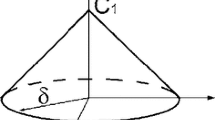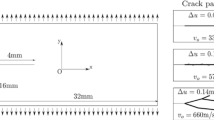Abstract
The phenomenon of stable crack growth in brittle materials is considered where stable crack growth is modeled as the formation of a bridge zone in the wake of a stably propagating main crack. The hypothesis that compressive zones surround and protect isolated ligaments under residual tension, which then leads to stable crack growth with attendant toughness enhancement, is incorporated into the bridge-zone formulation. Effects associated with debonding of ligaments on stable crack growth are explored via a simple treatment of microcrack branching. Similarity between the present bridge-zone description and a previously developed process-zone description of stable crack growth is quantitatively established. The importance of interpreting experimentally determined resistance-curve data subject to K-dominance requirements is highlighted by comparison of model predictions with select data in the literature.
Similar content being viewed by others
References
D.K.M. Shum, International Journal of Fracture 75 (1996) 95–114.
M.V. Swain, Journal of Materials Science Letters 5 (1986) 1313.
P.L. Swanson, C.J. Fairbanks, B.R. Lawn, Y.W. Mai and B.J. Hockey, Journal of the American Ceramic Society 70 (1987) 279.
G. Vekinis, M.F. Ashby and P.W.R. Beaumont, Direct Observation of Fracture and the Damage Mechanisms of Ceramics, Cambridge University Report CUED/C-MATS/TR 148 (1988).
H. Hubner and W. Jillek, Journal of Materials Science 12 (1977) 117.
R. Knehans and R. Steinbrech, Journal of Materials Science Letters 1 (1982) 327.
P.L. Swanson, Journal of Geophysical Research 92 (1987) 8015.
R.G. Hoagland, A.R. Rosenfield and G.T. Hahn, Metallurgical Transactions 3 (1972) 123.
M.D. Thouless, Journal of the American Ceramic Society 71 (1988) 408.
B. Budiansky, J.C. Amazigo and A.G. Evans, Journal of the Mechanics and Physics of Solids 36 (1988) 167.
Y-W Mai and B.R. Lawn, Journal of the American Ceramic Society 70 (1987) 289.
M. Ortiz, International Journal of Solids and Structures 24 (1988) 231.
S.N. Chatterjie, International Journal of Solids and Structures 11 (1975) 521.
K.K. Lo, Journal of Applied Mechanics 45 (1978) 797.
M.Y. He and J.W. Hutchinson, Kinking of a Crack Out of an Interface, Harvard University Report MECH-113 (1988).
Author information
Authors and Affiliations
Rights and permissions
About this article
Cite this article
Shum, D.K.M. Analysis of stable crack growth in brittle materials Part II: A bridge zone model. Int J Fract 75, 115–136 (1996). https://doi.org/10.1007/BF00034072
Received:
Accepted:
Published:
Issue Date:
DOI: https://doi.org/10.1007/BF00034072




